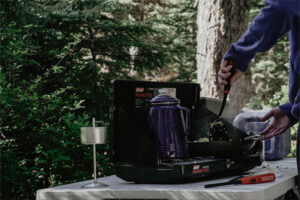
Common Materials Used for Camping Chairs
The most common materials used to make camping chairs are steel or aluminum for the frame and polyester, nylon, or mesh for the seat and backrest. These materials offer a harmony between comfort, weight, and durability.
Going further, aluminum is a popular frame material for contemporary camping chairs because of its remarkable strength and low weight. One benefit of aluminum frames is that they are frequently resistant to corrosion, which makes them perfect for a variety of outdoor environments. Contrarily, steel is more resilient and can hold a higher weight, although it may be slightly heavier and needs to be coated to avoid rust.
The seating area often uses fabrics like polyester and nylon as comfort and breathability are its top priorities. Polyester is a little bit heavier than nylon, but it resists UV deterioration better. Both materials are renowned for their ability to withstand wear and tear. When it comes to lightweight materials, nylon excels, providing a smooth texture and remarkable tensile strength. Chairs with mesh panels or inserts may be a game-changer for those hot summer travels, increasing ventilation and decreasing the likelihood of a sticky back.
When you unfold your camping chair after a strenuous day of hiking, the combination of these materials guarantees that it will be ready to offer a dependable and pleasant place to rest.
Aluminum
Aluminum is one of the lightest metals used in outdoor gear, making it a popular choice for campers who want strength without sacrificing mobility. Another benefit is that it naturally resists corrosion, which is very useful for people who camp near water or in humid situations. Although aluminum lacks the sheer strength of steel, it has an excellent strength-to-weight ratio, which makes it a great option for hikers and backpackers who are mindful of every ounce they carry.
Steel
Robust, steel is the material of choice for camping chairs that are intended to carry a greater load and withstand adverse weather conditions. It provides an unmatched level of durability, guaranteeing that the chair will stay steady even on uneven surfaces. But there’s a cost associated with this: steel weighs more than aluminum. Most steel-framed camping chairs have protective coatings applied to them to counteract their innate tendency to rust, which extends their longevity and dependability throughout a range of weather circumstances.
Polyester
Polyester is a highly preferred material for the sitting and backrest sections of camping chairs due to its exceptional durability and adaptability. Its resilience to UV radiation is one of its main advantages, as it lowers the possibility of the material fading or breaking down after extended sun exposure. Furthermore, polyester has a reputation for drying rapidly, which is an important quality for those unplanned downpours when camping and guarantees a dry seat in a short amount of time. The majority of camp chairs are manufactured mostly of polyester for the fabric, as you can see in the chart below.
Nylon
Nylon has earned a spot in the outdoor gear industry since it is robust and lightweight. It provides a silky feel and remarkable abrasion resistance in camping chairs, guaranteeing durability. Its featherweight characteristics typically makes it a popular choice for ultralight camping gear, even if it might not be as UV resistant as polyester. In addition to its many desirable properties for outdoor seating solutions, nylon may efficiently repel water when treated or coated.
Considerations When Buying a Camp Chair
Knowing what the market has to offer and being aware of your demands are key factors in selecting the ideal camping chair. By taking these factors into account, you can make sure that every outdoor activity is accompanied by a dependable and cozy place to relax.
Budget: A budget is one of the first things that many campers think about. The materials used, brand reputation, and extra features may all have a big impact on the cost of camping chairs. To help you limit down your selections and make sure you’re getting the greatest value for your money, it’s essential to set a budget range before you go shopping.
Material: As we’ve already covered, the material has a big impact on the chair’s weight, longevity, and general durability. Steel is strong, aluminum is lightweight, and materials like nylon and polyester combine comfort and durability. The type of material you choose may have a big impact on your camping needs and appearance.
Weight Capacity: When it comes to weight capacity, not all chairs are made equal. Make sure the camping chair you select can accommodate your weight safely and comfortably. This is especially important for those who are larger or who enjoy having a pet or youngster jump on their lap from time to time.
Comfort: The main goal of a chair is to provide comfort. A comfortable seat, an ergonomic design, or movable armrests are some elements to look for. Mesh-paneled chairs may provide more airflow, which makes them perfect for warmer weather.
Durability: Purchasing a sturdy chair is a smart move for people who spend a lot of time in the great outdoors. Make that the chair is sturdy on different types of terrain, the joints are well-constructed, and the cloth doesn’t break easily. Recall that a chair with greater durability often requires fewer replacements over time and offers better long-term value.
Portability: The chair’s portability becomes crucial if you have to hike or backpack to your camping location. Seek for seats that are easy to fold up, have carrying bags included, or even attach to your backpack. Portability is also influenced by weight; chairs that weigh less are simpler to move.
Cool Features: In the modern age, camping chairs aren’t just about sitting. Many include built-in coolers, adjustable reclining settings, storage pockets, and cup holders, among other things. These extras may greatly improve your camping experience, even if they may slightly raise the price.
Versatility: Consider the areas in which you plan to utilize the chair most frequently. Specific attributes are required if it is just going to be used for camping. Versatility is essential, too, if you want to use it for other outdoor activities, such as festivals or beach vacations.
Conclusion
There’s more to choosing the ideal camping chair than merely finding a spot to sit. It all comes down to characteristics that improve your outdoor experience, resilience to endure the unpredictable nature of the outdoors, and comfort during those downtimes. The choice should be made by weighing your demands, your intended use, and your budget, just as with other outdoor gear.
Every traveller can find the perfect camping chair thanks to the wide range of alternatives available today. Therefore, make sure you’re sitting in a chair that is comfortable for you whether you’re enjoying a bonfire, a sunset, or just the peaceful sounds of nature.






